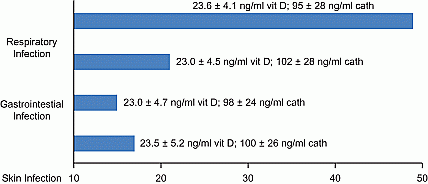ICCBH2015 Poster Presentations (1) (201 abstracts)
Association between serum 25-hydroxyvitamin D and incidence of infections in 6--12 years old children in a semi-rural setting in Western Maharashtra, India
Rubina Mandlik 1 , Neha Kajale 1 , Shashi Chiplonkar 1 , Vivek Patwardhan 1 , Supriya Phanse-Gupte 1 , Vaman Khadilkar 1 , Zulf Mughal 2 & Anuradha Khadilkar 1
1Growth and Endocrine Unit, Hirabai Cowasji Jehangir Medical Research Institute, Jehangir Hospital, Pune, Maharashtra, India; 2Royal Manchester Children’s Hospital, Manchester, UK.
Objectives: Previous studies have shown that burden of infections is greater in those with low body stores of vitamin D. Vitamin D is a key mediator of innate immunity and is crucial in production of cathelicidin, a potent antimicrobial agent. Vitamin D deficiency is common among Indian children; the prevalence of infections is high. Thus, aims of our study were to examine the association between: i) serum 25-hydroxyvitamin D (25OHD) concentrations and symptoms of infections and ii) 25OHD and cathelicidin concentrations in 6–12 years old in a semi-rural setting.
Methods: Cross-sectional study carried out in 432 children (6–12 years) in a primary school in a semi-rural area near Pune, India (18°N). Information on infection-related symptoms during the preceding fortnight was collected using a validated questionnaire administered to parents and children. Biochemical assessments included serum 25OHD (EIA Kit, DLD Germany) and cathelicidin (on a sub-sample of 160; EIA Kit, Cusabio).
Results: Mean 25OHD concentrations were 23.4±4.2 ng/ml; 32% children had vitamin D deficiency with 25OHD ≤20 ng/ml (IOM 2011). 25OHD concentrations were positively correlated with cathelicidin levels (r=0.3; P<0.01). Respiratory symptoms were reported by 49%, fever by 35%, gastrointestinal infections by 21%, skin infections by 15%, and other infections (ocular, urinary) by 17% (Fig. 1). No correlation was found either between serum 25OHD or cathelicidin and the infection-related symptoms reported by subjects.
Discussion: We found that vitamin D status of children was not associated with their infection related symptoms, possibly as over two-thirds of children were vitamin D replete, with 25OHD concentrations ≥20 ng/ml.
Disclosure: The authors declared no competing interests.

Figure 1 Percentage of infection-related symptoms with mean ± S.D. of 25OHD and cathelicidin concentrations.
 }
}



